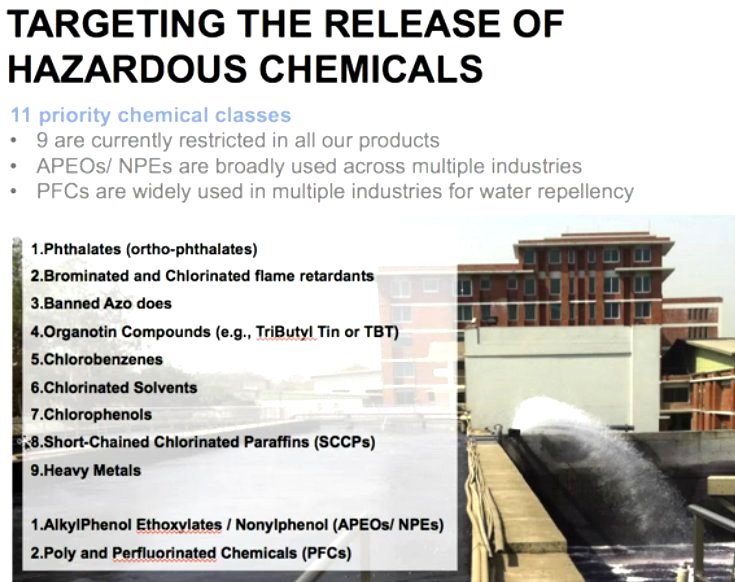 Detox has been a repeat topic on this blog. Most recently after my visit in May to Performance Days, but also previously (e.g. here, and here).
Detox has been a repeat topic on this blog. Most recently after my visit in May to Performance Days, but also previously (e.g. here, and here).
While slowly but surely more and more brands (17 at the time of writing) – and retailers – have signed a Detox Solution Commitment with Greenpeace, and hence work in some way or other with ZHDC (Road map to Zero), a key threshold was passed event most recently: With the Italian fabric mill Canepa, the first manufacturer has taken the pledge.
Canepa opened up a new chapter in their company history with the development of their Methacrylamide-free Kitotex finishing processes (the sustainability benefits were discovered as a side effect). Since, the company has done a fairly good job at learning on the go, as can be seen in their SAVEtheWATER project), a rather brave step for what is a manufacturer, and which sets a new benchmark industry wide.
With that in mind, it is time to have a closer look at Detox and ZDHC in more detail, as well as some of the Detox Solution Commitments that were signed by brands.
ZDHC (Roadmap to Zero): What is it
ZDHC is a few things at once, and indeed can be looked at from a variety of angles.
For one, there is of course the 2020 ‘Detox to Zero’ commitment pledge that signatories sign up to. This constitutes ultimately the consortium’s raison-d’etre, yet there is more to this.
While ZDHC is entirely focused on apparel and footwear at this point in time, it has evolved into a cross-industry (indeed), multi-tier working group, with a system approach (cf. video).
- Why cross industries?
For 2 principle reasons, and to name an example. 1) Because all of the 11 chemical categories that the consortium currently focuses on are used not just in apparel and footwear, but also in other manufacturing industries. 2) Because as a consequence of the system approach, the chemical and agricultural industry are relevant for the bigger picture due to their manufacturing or use of dye stuffs, fertilizers, pesticides etc. - Why multi-tier?
From a brand’s perspective, but also from the point if view of a high-end manufacturer such as Canepa, their relation with their immediate suppliers is just the beginning of their ZDHC efforts. If ‘Zero Discharge’ is the ultimate goal, the journey starts with the raw material, ultimately. While a brand may – in the present and for the immediately foreseeable future – not be able to build direct relations with and thereby influence on suppliers deeper down in their supply chain, knowing the chemical processes involved in those processes, will allow to develop handling strategies and alternatives to them. This therefore, aligns with the ZDHC’s ultimate goal.
Joint Roadmap – outline
The Joint Roadmap – the official document that defines the working packages and anticipates achievements and milestones – contains a mix of work packages, hard fact deliverable, and procedural solution approaches.
The short-term deliverable focus on 2 aspects: 1) an objectivised and transparent process on how to assess and rate chemicals used in the industry; and 2) a list of chemicals, including prioritization, to be faded out, or to which alternatives have to be researched. To achieve this, it will have to be e.g. known what formulations (recipes) are used, the processes that are in place.
At the bottom line the Roadmap, is primarily an explanation of How the consortium intends to get to the goal, the process they intent do follow, the challenges they encounter overall, and how much of the road they have managed (or not) to travel.
It contains itself few hard facts and data – other then the published documents e.g. the chemicals index.
Detox Solution Commitments: What they mean; Samples

The role of hard deliverables is assumed by the Detox Solution Commitments that each signatory signs. While the structure of the document is in essence the same for all brands (Who, What, How, until When), the specifics of each Commitment varies from signatory to signatory. Taking three examples (Brand: Levi’s; Retailer; Coop Switzerland; Manufacturer: Canepa), I will have a summarised look at how this specifics work out in individual cases.
- Levi’s (brand)
What and Until When:
– publication of restricted chemical substance list (June 2013 for the first time; incl. revision every 6 months);
– beginning public disclosure of limits and test results for their supplying facilities, including name and location of facility (25 till June 2013, 40 till 12/2013);
– budget for research and training to eliminate APEOs asap; elimination of C7 and C8 (PFC) chemicals by end of year 2013;
– already include other hazardous chemicals beyond the 11 considered in the core group (ongoing; in collaboration with other signatories)
– produce documentation of internal case studies where they have achieved elimination of chemicals previously: how it has been achieved and the actual results. - Coop Switzerland (Retailer)
What and Until When:
– publication of restricted chemical substance list (April 2013 for the first time; incl. revision every 12 months);
– end of 2013: adoption of a new minimum standard for textile/apparel/footwear of owned brands, asking for elimination of hazardous chemicals use and discharges in the entire supply chain incl. adoption of stringent testing program and strict regulations with sanctions for suppliers that don’t comply.
– beginning public disclosure of limits and test results for their supplying facilities, including name and location of facility (5 till June 2013, 15 till 12/2013);
– execute a supply chain analysis re. APEOs entering it; assess current levels of compliance and report them publicly; allocate budget for training and collaboration with suppliers;
– entirely eliminate PFCs in own brand product’s supply chain by no later than the end of September 2013. - Canepa (Manufacturer)
What and Until When:
– publication of restricted chemical substance list (January 2014 for the first time; incl. revision every 12 months);
– public disclosure of names and locations of all their supplying facilities in the ‘global south’ including China; by April 2014 public disclosure of discharge and test results equivalent to at least 40% of their overseas production; by October the disclosure of any further suppliers and discharge disclosure of 80% of their supply chain.
– APEOs: prohibit APEO usage in contract agreement with suppliers by January 2014; document alternatives used, strengthen testing procedures.
– Eliminate C7+ PFC by September 2014; all other types of PFCs by July 2015. Including documentation of replacements and testing/audits.
– Prohibit the use of Phthalate contractually by January 2014; release report of current compliance by January 2014.
– Eliminate methacrylamide from their entire product range by April 2014.
Conclusion: All good, but …
Looking at the three examples mentioned above, the most interesting aspect – from my perspective – is the fact that Canepa, a manufacturer, has put the most challenging, encompassing and concrete targets forward. This is a good development – suggesting that as a manufacturer they have a rather good grip on their supply chain.
In contrast, the brands and retailers seem to see more hurdles, and more so with the size their operations grow (Levi’s vs. Coop Switzerland).
Finally, the lack of common KPIs to measure the pace at which ZDHC proceeds is a worry. There is of course the Benchmark report which was release earlier this year. Which however is only the results as tested and measures in 20 Chinese facilities.
How well hence, this interlacing concept of general collaboration agreement (Roadmap) and individual Commitments ultimately will pan out remains to be seen. There are plus and minuses to this approach. The risk of course being that the agenda is pushed by 1 or 2 very capable and very committed brands and/or manufacturers – but that the rest of the consortium follows only sluggishly. It is at this moment difficult to assess with how much commitment and zeal the work packages are being undertaken and delivered.
Ultimately – the course of action and results over the next 12 to 24 months will give a good indication of indeed the 2020 time limited will be achieved.

